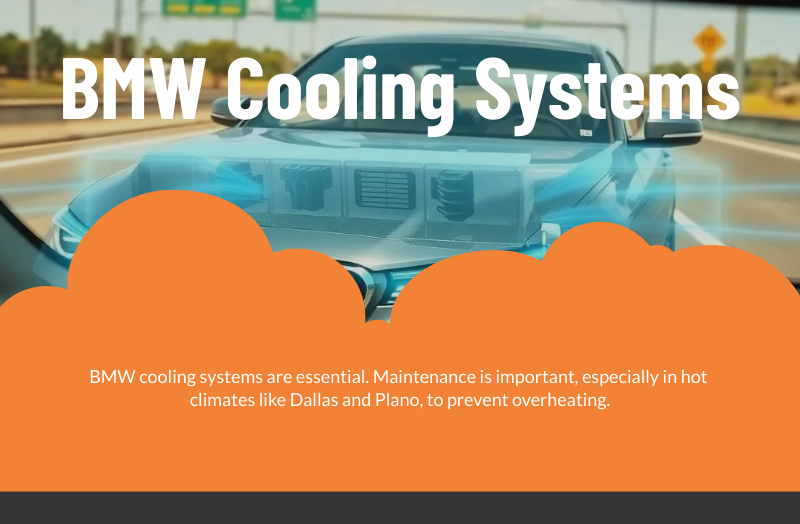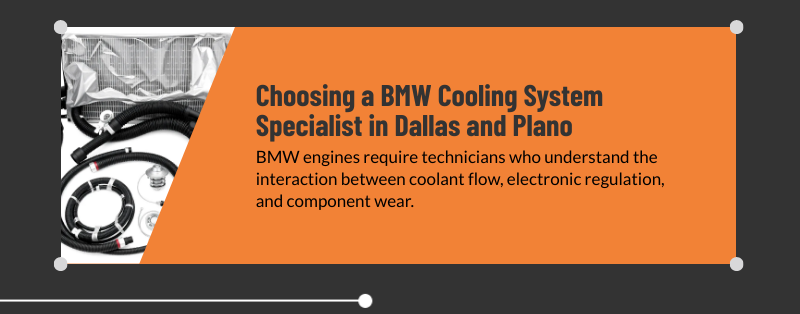Understanding the Role of a BMW Cooling System
BMW engines rely on a tightly engineered cooling system that manages heat, stabilizes operating temperature, and protects internal components under load. The system uses a balanced combination of coolant, flow control components, electric pumps, thermostats, and sensors to maintain temperature precision. Consistent performance depends on clean fluid, leak-free operation, and accurate electronic regulation.
A modern BMW cooling system is designed to maintain optimal thermal stability even during aggressive driving or extended idling common in Dallas and Plano traffic conditions. When the system begins to degrade, temperature fluctuations create stress on gaskets, hoses, and internal metals. This makes cooling system maintenance one of the highest-value preventive services for BMW ownership.
Key Components Found in BMW Cooling Systems
BMW cooling systems combine mechanical, electrical, and software-driven components. Each plays a distinct role in maintaining safe engine temperature.
Radiator
The radiator transfers heat from coolant to outside air. BMW radiators are lightweight aluminum units with tightly spaced fins. Damage, internal clogging, or degraded plastic end tanks restrict flow and increase temperatures under load.
Electric Water Pump
Many BMW engines use an electric water pump rather than a belt-driven version. Electric pumps provide more consistent flow and better temperature regulation, but they can suffer internal wear without warning. Sudden overheating events are common symptoms of pump failure.
Thermostat
BMW thermostats control coolant temperature by regulating flow volume. When a thermostat sticks closed, the engine overheats quickly. When stuck open, the engine runs too cool, reducing efficiency and increasing emissions. Thermostat issues are frequent on high-mileage BMWs.
Coolant Expansion Tank
Expansion tanks maintain coolant volume stability as temperatures fluctuate. Many BMW models are known for expansion tank fatigue due to heat cycling. Cracked tanks produce rapid coolant loss and visible leaks near the passenger-side front of the engine bay.
Cooling Fan and Fan Clutch
The auxiliary fan increases airflow through the radiator during idle or low-speed driving. Fan failure is a common cause of overheating in stop-and-go Dallas and Plano traffic. Vehicles equipped with fan clutches can experience reduced airflow when the clutch loses engagement strength.
Hoses, O-rings, and Seals
BMW uses a network of vacuum-sealed hoses and molded plastic connectors throughout the cooling path. These components wear from age, heat, and vibration. Small leaks often escalate into major coolant loss if not addressed early.
Why BMW Cooling Systems Are Prone to Wear in Dallas and Plano
BMW models rely heavily on plastic components throughout the cooling system, which are sensitive to repeated thermal cycles. Dallas and Plano conditions expose those components to extended periods of heat, especially in congested corridors such as US-75, the Dallas North Tollway, and President George Bush Turnpike. Long idle times combined with high ambient temperatures accelerate cracking, brittleness, and seal deterioration.
Urban stop-and-go patterns also increase the workload on electric water pumps and cooling fans. While BMW cooling systems regulate temperature well at highway speeds, slow-moving local traffic exposes the weakest parts of the system. As components degrade, pressure imbalances develop, making leaks more likely to appear around connectors, pump housings, and reservoir seams.
Vehicles used for short trips in Plano neighborhoods or Dallas urban centers experience incomplete warm-up cycles. Inconsistent thermal patterns reduce coolant lifespan and promote sediment formation, which restricts internal passages. Combined with the natural aging of plastics, this environment raises the likelihood of cooling system issues appearing earlier than many owners expect.
Signs of Cooling System Failure in BMW Models
Cooling system issues rarely resolve on their own. Early symptoms provide insight into component wear or flow restriction.
Rising Engine Temperature
A temperature gauge climbing into the upper range indicates restricted flow or a failing pump. BMW vehicles equipped with digital temperature warnings may display yellow or red alerts as overheating risk increases.
Coolant Smell or Visible Leaks
Sweet coolant odor from the engine bay, puddles near the front bumper, or low coolant warnings indicate an external leak. Expansion tanks, hoses, quick-connect fittings, and radiators are common sources.
Overheating During Idle
If temperatures rise while idling in traffic but stabilize while driving, the auxiliary fan or fan control module may be failing. Slow airflow prevents adequate cooling during stationary operation.
Frequent Coolant Top-Offs
If coolant levels repeatedly drop without visible puddles, small leaks or slow evaporative losses within the system are likely. Internal system pressure forces coolant out of weak seals only while the engine is running, making leaks harder to detect.
Heater Malfunction
A cooling system that cannot maintain proper coolant flow may cause inconsistent cabin heat. Air pockets within the system trick the heater core into cycling temperature.
Engine Misfire or Rough Operation
Severe overheating events can affect cylinder sealing and combustion stability. While less common than external symptoms, misfires following an overheating incident indicate advanced thermal damage.
Typical Cooling System Services for BMW Models
BMW cooling system service involves both maintenance and component-level repair work. The right procedure depends on the vehicle’s symptoms, age, and maintenance history.
Coolant Drain and Refill
Replacing old coolant removes contaminants and restores thermal protection. BMWs require the correct coolant formulation to avoid corrosion, internal clogging, and pump wear. A drain and refill includes removing old coolant, flushing the system as needed, refilling with fresh coolant, and bleeding trapped air.
Cooling System Bleeding
BMW vehicles require precise bleeding procedures to eliminate air pockets in the system. Air trapped within hoses or the water pump reduces flow and increases overheating risk. Professional bleeding ensures steady temperature distribution.
Pressure Testing
A pressure test identifies leaks by simulating operating pressures without heating the engine. This test reveals weak seals, cracked hoses, reservoir damage, and radiator faults.
Water Pump and Thermostat Replacement
Electric water pumps and thermostats are common wear items. Replacing them restores stable flow and temperature regulation. Many BMW owners opt to replace these components proactively around common mileage intervals.
Radiator or Expansion Tank Replacement
Cracks in plastic end tanks or expansion reservoirs remain one of the most common repairs. These components degrade from heat cycles and must be replaced with properly matched materials.
Hose and Connector Replacement
Aging hoses and O-rings lose elasticity. Replacing them prevents leaks and restores system pressure integrity.
Cooling Fan or Fan Module Repair
Fan assemblies and control modules require proper function in Dallas and Plano stop-and-go traffic. Repairs restore airflow and reduce overheating risk during idle.
How Often BMW Cooling System Service Should Be Performed
BMW coolant degrades over time due to heat cycling and internal chemical breakdown. Drivers in Dallas and Plano may require shorter service intervals due to the region’s consistently high temperatures and heavy traffic.
A typical drain and refill is performed during major service intervals, but component-level repairs often occur sooner. Water pumps, thermostats, hoses, and expansion tanks do not follow a guaranteed lifespan and frequently require inspection during routine service visits. Engines exposed to long idling periods or aggressive driving patterns may benefit from earlier coolant replacement or diagnostic testing to confirm stable operating temperatures.
Although BMW’s onboard service computer provides alerts for some coolant-related events, many cooling system failures occur without warning. Periodic inspections reduce the likelihood of unexpected overheating or roadside breakdowns.
Cost Expectations for BMW Cooling System Service in Dallas and Plano
Cooling system costs vary depending on the components involved and the vehicle’s condition. Basic coolant service is straightforward and usually falls within a predictable range. More advanced repairs involving the water pump, radiator, or thermostat require higher labor time and OEM-approved parts.
Entry-level coolant services address fluid replacement, air bleeding, and system pressurization. Drivers can expect higher costs when repairs involve component replacements or multiple interdependent parts. For example, replacing several hoses at once is often more efficient than waiting for individual failures. Vehicles with high mileage, extensive heat exposure, or repeated maintenance delays may require broader system refresh work.
Independent BMW-focused shops in Dallas and Plano commonly offer competitive pricing compared with dealership service departments. Many shops provide BMW-specific diagnostic tools, coolant formulations, and repair procedures that align with factory requirements.
Why Prompt Cooling System Repair Is Crucial for BMW Engines
BMW engines generate significant heat during operation, and even short overheating episodes increase the likelihood of long-term damage. Head gasket failure, warped cylinder heads, and compromised aluminum components are all risks when a cooling system cannot maintain stable temperature. These repairs are extensive, costly, and time-intensive.
Early intervention prevents heat-induced stress on the engine block, turbochargers, and auxiliary components. Addressing small leaks or pump irregularities preserves system pressure and protects the engine from thermal events. Ensuring proper coolant flow also helps maintain emission control performance and overall drivability.
Dallas and Plano traffic environments increase the thermal load on cooling systems during warmer months. Preventive service reduces the likelihood of unexpected overheating in heavy traffic, construction zones, or long commutes.
BMW Models Most Likely to Experience Cooling System Failure
All BMW models use cooling systems with plastic and electronic components, but certain engines have higher wear patterns.
BMW 3 Series and 5 Series
These high-volume models feature electric water pumps that commonly experience internal wear around moderate mileage. Thermostat assemblies also show frequent age-related issues.
BMW X5 and X3
SUVs produce additional heat due to weight and load. Expansion tanks and hoses experience higher pressure fluctuations, creating leak potential.
BMW 7 Series
Larger engines with complex coolant routing can develop leaks in hidden areas. Routine inspections are essential for identifying early-stage faults.
BMW M Models
Performance models run hotter due to increased power output. Track use or spirited driving accelerates wear on pumps, radiators, and thermostats.
Environmental and Usage Factors Affecting BMW Cooling Systems
Cooling system wear is influenced by both operating environment and driving habits. Dallas and Plano drivers often encounter conditions that intensify wear.
High Ambient Heat
Texas temperatures produce more aggressive thermal cycling throughout the year. Plastic components around the coolant path weaken at a faster rate.
Urban Stop-and-Go Driving
Frequent idling increases reliance on the cooling fan. Fan assemblies and control modules experience accelerated wear under these conditions.
Short Commutes
Inconsistent engine temperatures promote condensation and coolant contamination. Systems that rarely reach full operating temperature see reduced coolant lifespan.
Heavy AC Usage
Extended air-conditioning operation increases engine load and temperature regulation requirements. Cooling fans and pumps work harder to maintain stability.
Highway Driving Mixed With Urban Traffic
Transitions between high-speed airflow and slow-speed congestion increase thermal variability. Components expand and contract more frequently, contributing to sealing fatigue.
Ensuring Correct Coolant Formulation for BMW Models
BMW engines require specific coolant blends to prevent corrosion, scaling, and pump wear. Using universal or incorrect formulations increases the risk of internal buildup and premature component failure. Proper BMW-approved coolant supports stable temperature regulation and consistent pump lubrication.
Dallas and Plano repair facilities familiar with BMW requirements maintain stock of the correct coolant types and bleeding equipment. During service, the technician must remove air pockets and verify flow consistency with the electric pump. Inadequate bleeding produces temperature spikes that put stress on nearby components.
Why Professional Diagnostics Are Essential for BMW Cooling Systems
BMW cooling systems rely on electronic sensors and precise control logic. Professional diagnostic tools read live data from thermostats, pumps, fan modules, and temperature sensors. These values reveal early signs of component failure, flow restriction, or system imbalance.
Shops equipped with BMW-specific diagnostic platforms interpret these readings accurately. Real-time data helps identify failing pumps, inconsistent thermostat behavior, or intermittent electrical faults. This prevents unnecessary part replacement and ensures repairs address the root cause.
Dallas and Plano independent BMW specialists typically maintain the diagnostic equipment necessary for accurate analysis. Accurate interpretation reduces guesswork and unnecessary repair cycles.
Cooling System Service at Autoscope
Autoscope provides cooling system service at its Dallas location, offering repairs for radiators, water pumps, thermostats, and associated components. The shop addresses coolant leaks and pressure irregularities by inspecting hoses, connectors, and related parts within the system. Coolant flushes are performed using BMW-approved coolant to maintain proper temperature control and engine longevity.
Technicians diagnose issues that lead to overheating by testing system flow, checking for leaks, and ensuring electronic components related to cooling are functioning correctly. The shop’s published cooling-system information emphasizes restoring safe operating temperature, preventing major engine damage, and maintaining long-term reliability. Autoscope’s procedures align with BMW requirements for coolant type, bleeding, and pressure verification.
Choosing a BMW Cooling System Specialist in Dallas and Plano
Selecting the right repair shop affects long-term engine health. BMW engines require technicians who understand the interaction between coolant flow, electronic regulation, and component wear. Shops familiar with BMW cooling system architecture can identify early-stage issues that general repair facilities may overlook.
A qualified shop uses BMW-compatible diagnostic tools, performs bleeding procedures accurately, and identifies whether faults originate from flow restriction, electrical irregularities, or component fatigue. Dallas and Plano have numerous general repair options, but BMW-focused shops provide enhanced insight into model-specific wear patterns and repair priorities.
Drivers benefit from choosing facilities that prioritize transparent inspection, clear diagnosis, and use of coolant formulations compatible with BMW specifications. Consistent service records also ensure resale value by documenting repair intervals and component replacements.
When Full Cooling System Refresh Is the Best Approach
BMW cooling system components often wear together due to similar heat exposure, age, and pressure cycling. When multiple items show early signs of failure, a full system refresh restores long-term reliability. This approach replaces the pump, thermostat, expansion tank, hoses, and connectors at the same time.
A comprehensive refresh reduces the likelihood of repeated repair visits and eliminates pressure imbalance throughout the system. For vehicles exposed to long commutes, heavy traffic, or extreme temperatures, this approach creates a stable baseline for future maintenance.
Preventive Maintenance Strategies for BMW Cooling Systems
Preventive care reduces the risk of sudden overheating or roadside breakdowns. A structured maintenance approach helps identify failing components early.
Periodic Coolant Replacement
Fresh coolant maintains stable flow and prevents internal corrosion. Replacement intervals depend on driving conditions, thermal exposure, and system age.
Routine Pressure Testing
Pressure tests performed during service visits reveal leaks before they escalate. Identifying weak connectors or hose deterioration reduces emergency repair situations.
Electric Water Pump Monitoring
Technicians review pump performance data to detect irregular flow, increased runtime, or electrical faults. Early detection prevents overheating cascades.
Thermostat Behavior Review
Monitoring temperature fluctuations helps identify thermostats beginning to stick. Preventive replacement maintains consistent cooling performance.
Fan Module and Auxiliary Fan Inspection
Ensuring both units operate at correct speeds protects vehicles in summer conditions or congested Dallas roadways.
Impact of Delayed Cooling System Repair
Delaying cooling system repair increases the risk of internal damage. Even brief overheating events strain gaskets and weaken aluminum components. Water pump failure or thermostat malfunction quickly escalates to high-temperature operation.
Ignoring small leaks allows air into the system, creating temperature spikes and flow imbalance. These issues place stress on the coolant passages, heater core, and turbocharger components. Repairs become more expensive as damage spreads beyond the immediate fault.
Dallas and Plano’s heat intensifies failure consequences. Drivers experiencing rising temperature readings or coolant loss should seek immediate diagnosis to prevent long-term issues.
FAQ: BMW Cooling System Service in Dallas & Plano
How often should a BMW coolant system be serviced?
Service intervals depend on driving conditions and temperature exposure. Dallas and Plano drivers often benefit from more frequent coolant replacement and inspections due to heat and traffic patterns.
What are common signs of BMW cooling system problems?
Signs include overheating, coolant leaks, sweet smells, fluctuating temperature readings, poor cabin heat, and repeated low coolant warnings.
Why do BMW water pumps fail more frequently than other brands?
Many BMW models use electric pumps with internal components that degrade over time. Heat cycling and electrical load contribute to wear.
How much does BMW cooling system repair typically cost?
Basic coolant service has predictable pricing, while component replacements such as pumps, radiators, and thermostats increase the overall cost. Multiple repairs at once improve long-term reliability.
Can I continue driving if my BMW shows a low coolant warning?
Driving with low coolant increases the risk of overheating. Immediate inspection is recommended to prevent engine damage.
What causes coolant leaks in BMW vehicles?
Leaks often originate from hoses, expansion tanks, radiators, and quick-connect fittings. Heat exposure in Dallas and Plano accelerates wear.
Is a coolant flush necessary for BMW models?
Coolant flushes maintain clean flow, prevent buildup, and protect pump components. They support stable operating temperature and reduce overheating risk.
Why does my BMW overheat in traffic but not on the highway?
Insufficient airflow at idle often indicates a failing cooling fan or fan control module. Highway airflow temporarily compensates for the reduced airflow.





